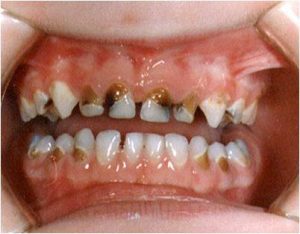Contents
Bottle syndrome
No, cavities do not only affect permanent teeth! A toddler who is regularly offered a bottle of sugary drink is exposed to bottle-feeding syndrome, characterized by multiple cavities affecting the baby teeth. Prevention and early treatment are essential to avoid serious consequences for oral health.
Bottle syndrome, what is it?
Definition
Bottle syndrome, also known as bottle cavity, is a severe form of early childhood decay, which manifests as the development of multiple cavities affecting the baby teeth, which progresses rapidly.
Causes
During early childhood, prolonged and repeated exposure to sugary drinks (fruit juice, soda, dairy drinks…), even diluted, is the cause of this syndrome. It often affects children who fall asleep with their bottle, hence its name.
Refined sugars promote acid production by bacteria in the mouth (lactobacilli, actinomyces and Streptococcus mutans). But breast milk also contains sugars, and a child who is breastfed after having started teething can also develop cavities.
Temporary teeth are more sensitive than permanent teeth to acid attack by bacteria because their enamel layer is thinner. They are also more difficult to clean. In addition, the young child sleeps a lot; however, the production of saliva, which plays a protective role, is greatly reduced during sleep. Under these conditions, the destruction of the teeth progresses rapidly.
Diagnostic
The dentist learns about the risk factors by questioning the parents and carefully examines the inside of the mouth. Most often, the diagnosis is easily made, as cavities are visible to the naked eye.
A dental x-ray can be used to determine the extent of caries.
The people concerned
Early childhood decay, which affects temporary teeth, is very common. In France, 20 to 30% of children aged 4 to 5 thus present at least one untreated decay. The bottle-feeding syndrome, which is a severe and precocious form of early childhood decay, affects around 11% of children between 2 and 4 years old.
Studies show that bottle-feeding syndrome is particularly common in disadvantaged and precarious populations.
Risk factors
Inappropriate use of the bottle (prolonged or at bedtime), poor oral hygiene and a lack of fluoride promote the early onset of cavities.
Hereditary factors are also involved, some children having more fragile teeth or a poorer quality enamel than others.
Symptoms of bottle-feeding syndrome
Cavities
The front teeth are the first affected, the first cavities usually appearing first on the upper ones, between the canines. Stains appear on the decayed tooth. As decay progresses, it digs into the tooth and can attack the neck.
The teeth take on a brown then blackish color. The demineralization of the enamel and then of the dentin makes them very fragile and they break easily. Without care, teeth eaten away by cavities end up reducing to stumps.
The most serious cavities are the cause of abscesses and inflammation of the gums. They are also responsible for attacks that endanger future permanent teeth.
pain
The pains are initially not very intense or even absent, then become acute when the cavities attack the pulp (the dentin) and begin to dig the teeth. The child complains when he eats and no longer tolerates contact with hot or cold.
Cavities can also be the cause of chronic pain or toothache when the nerve is affected.
Consequences
The bottle-feeding syndrome can have deleterious consequences on the development of the orofacial sphere, for example causing dental occlusion disorders when the mouth is closed, or even difficulties in acquiring language.
More broadly, it causes difficulty in chewing and eating and can be the source of undernutrition, with repercussions on growth. The child’s sleep is disturbed by pain, he suffers from headaches and his general condition deteriorates.
Treatments for bottle-feeding syndrome
Dental care
The dental care carried out in the office of the dentist must intervene as quickly as possible to stop the progression of cavities. Most often, the extraction of decayed teeth is necessary. It can be performed under general anesthesia when the disease is very advanced.
The fitting of pediatric crowns or small appliances may be proposed.
Background treatment
Fluoride tablets may be prescribed to stop the progression of the syndrome. However, the basic treatment, inseparable from dental care, lies above all in the implementation of hygienic and dietary measures: modification of eating behavior, learning to brush teeth, etc.
Prevent bottle-feeding syndrome
From an early age, the child should be used to drinking water. It is recommended to avoid offering him sugary drinks to calm him down, and especially to leave him the bottle to fall asleep.
The transition to solid food should not be delayed: by reducing the use of the bottle around the age of 12 months, we will reduce the risk of your child developing a bottle-feeding syndrome. On the condition, however, to limit refined sugars, for example by replacing them with bread! Also, the bacteria that cause cavities are often transmitted by parents. It is therefore better to avoid sucking on your child’s spoon.
Dental hygiene requires careful care from an early age. A wet compress can first be used to wipe the baby’s teeth and gums after a meal. Around the age of 2, the child will be able to start using an adapted toothbrush with the help of his parents.
Finally, dental follow-up should not be neglected: from the age of 3, dental consultations can be regular.










